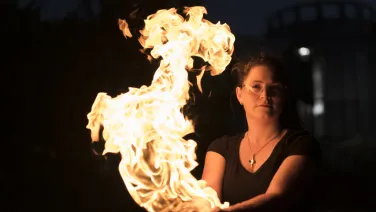Death caps: these killer mushrooms actually help trees to grow
Canberrans are rightly educated to be extremely wary of death caps, which are highly toxic to humans, and responsible for the majority of fatal mushroom poisonings worldwide.
With a track record – and a name – like that, it’s easy to think the defining feature of death caps is their toxicity.
But, it turns out, our human-centric perspective on the fungi doesn’t tell the full story of its role on the tree-lined streets of Canberra.
Professor Celeste Linde from the ANU Research School of Biology says the toxicity of death caps to humans is entirely coincidental. The poisonous compound they contain doesn’t even affect all other animals; it’s just an unlucky match between the composition of the mushroom and the metabolism of humans and other mammals which makes them deadly.
So death cap mushrooms don’t actually want to kill us. In fact, mushrooms don’t care about us at all.
“Mushrooms have not evolved with us in mind,” Professor Linde says. “In evolutionary terms, they have been around a lot longer than humans.”
If you take humans out of the picture, the biology of death cap mushrooms starts to look completely different.
Death caps are mycorrhizae, a type of fungi that associates with the roots of plants, such as, in the case of death caps, broad-leafed trees like oaks, birches and elms. It’s an association which is beneficial to both the fungi and the tree, Professor Linde explains.
“Because trees can photosynthesise and mushrooms can’t – because they don’t have chlorophyll –they draw photosynthates, like carbon, from the host tree.
“In return, the mycorrhizal fungi help the tree take up nutrients, especially phosphorus, and a bit of nitrogen, and provide plants with disease resistance, drought tolerance and all that good stuff.
“Basically, mycorrhizal fungi, like death caps, actually help plants grow better.”
And while host trees can live without mycorrhizae, they won’t thrive: “There are lots of experiments where people have grown trees with and without mycorrhizae, and those with mycorrhizae will end up taller and with much denser, and greener canopy leaves.”
It’s a beautiful natural relationship, she says, and as much part of the Canberra landscape as our oak-lined streets.
“To me, the sad thing about death caps is that they don't really belong here in Australia. But then we also have a lot of trees that don't belong here, and they go together. So we have to live with it now, and educate people about these mushrooms.”
Part of that education, she says, is to value them on their own terms.
“When I see a death cap, of course I think of how they are poisonous and how we shouldn’t eat them, but that’s not how I see their role in nature.
“Their role in nature is to help trees grow better, just like any other mycorrhizal fungi tries to do, and I admire that.”
“But,” she laughs, “I’m a biologist so maybe I’m just weird.”
Our weird biologists are internationally recognised for their high-impact research in plant sciences, evolution, ecology, genetics, parasitology and biotechnology. Explore biology at ANU as part of your undergraduate or postgraduate degree.




